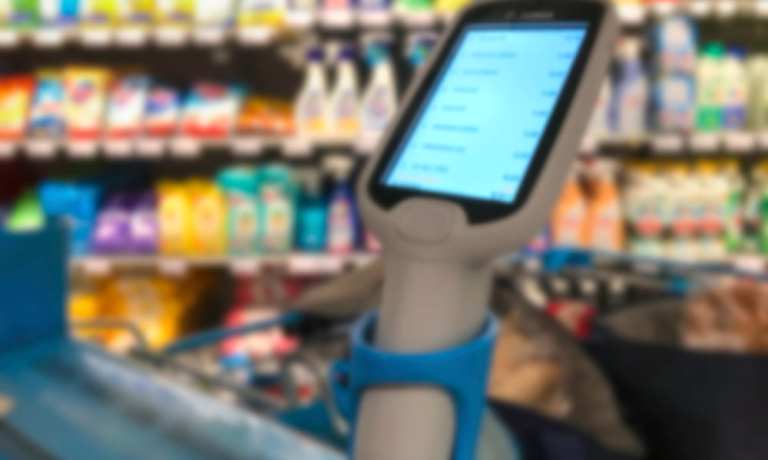
Raz Golan, CEO of Israeli-based mobile checkout company Shopic, says his company started out with the mission of shortening lines in grocery stores — a crowded space in and of itself these days. But with a recent $7.6 million in funding, the startup is on track to bring a unique blend of artificial intelligence (AI) and anti-theft technology to market.
The company currently markets four solutions, all aimed at grocery stores. Most of its biggest clients are under non-disclosure agreements.
Shopic’s core product is a mobile checkout app (white-labeled or branded) that lets consumers track and pay for items through their mobile devices without visiting the cashier station, and also allows associates to “line bust” and act as cashiers from any point in the store at any time.
The company’s second product addresses the main concern with cashierless technology, which is shrinkage. Called CartWatch, the solution is based on an artificial intelligence (AI)-based algorithm that collects hundreds of behavioral and historical data points. By detecting behavioral anomalies, CartWatch provides a strong layer of security for mobile checkout. Shopic claims that suspicious transactions can be flagged with up to 300 percent better accuracy than traditional solutions.
The company also offers a second set of newer products. Virtual POS is a cloud-based integration platform that allows grocers to dramatically cut integration times to weeks instead of months. It supports all types of pricing, promotions and tax rules. The newest technology enables frictionless payments via a device that is built into the handle of the shopping cart, using cutting-edge AI algorithms to identify each item that enters or exits the cart. In addition, wide-angle cameras from the cart map the store in real time and collect powerful insights to help stores boost sales and streamline operations.
“The goal of the platform is to provide three main things,” Golan told PYMNTS. “First, it aims to provide a seamless, quick and easy checkout experience for customers. Second, it allows retailers to better communicate with customers as they shop. Today, there is no real way of doing that other than mobile self-checkout solutions. Giving retailers that capability increases sales and provides a much better shopping experience, as customers are exposed to more promotions and personalized offers.”
Shopic’s technology has gotten more attention during the pandemic. Golan has seen an increase in two areas: The first is grocery retailers that were deemed essential during the lockdown, and were forced to deal with an influx of shoppers, some of which could be aggressive. The company has also developed technology that can help eCommerce grocery sales. As consumers place orders, store personnel can more easily pick, pack and process payments with the Shopic platform.
“With our mobile self-checkout solution, the demand was high because it helps grocery retailers provide a much more private shopping experience. And shoppers don’t have to interact with anyone or wait in line, so it really helps social distancing,” Golan noted. “In addition to supporting the stores in which we already operate, we also increased our new stores to allow customers to go in and out quickly with a minimum of interaction.”
The seamless process presented by the Shopic platform has several ripple effects, according to Golan. First, he believes grocery retailers are still interested in getting people into physical stores, because those visits are more profitable than the delivery costs and potential fees involved in eCommerce. Second, his company’s research shows that with cashierless checkout, shoppers stay on the sales floor longer because they know checkout is no longer a drag on their time. In fact, basket sizes for Shopic clients are 16 percent higher than average.
“From the retailer’s perspective, the online business is much less profitable than brick and mortar, so grocery retailers are actively pushing customers to get into stores, where they can get a great upsell rate,” Golan noted. “Once you give a customer a unique and smooth experience in a physical store, they will come more often, even at peak hours, because all the stuff that’s not so much fun is taken out of the equation.”
Shopic’s claims are supported by a recent PYMNTS report, which found that 78.1 percent of digital wallet users would rather make purchases through non-traditional, unattended means and enjoy using such offerings because they are faster (49.4 percent), have shorter lines (34.7 percent) and allow consumers to take their time when making purchases without having to talk to employees (33 percent).
“We are a team that is not only technological, but we also really understand retail and how much of an operational organization it is,” Golan said. “Our solution is not just the technology, but the entire shopping experience. And we put a lot of emphasis on how cheap the solution should be in terms of costs, how quick it should be deployed in the store, and how easy it should be to maintain. And we don’t want to interfere with the store’s day-to-day operations. We want it to be as smooth as possible.”